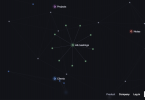I enjoyed Cortex Futura’s latest post on algorithms of thought (“True Algorithms of Thought Have Arrived” – CortexFutura.com). In reflecting on the role algorithms of thought have played in my own life and work, I’d agree that new technologies for sharing algorithms of thought have arrived (especially with the advent of Roam Research). But the algorithms of thought themselves — and ways to share them — have actually been around for quite some time.
Algorithms have Nothing to do with Al Gore
An algorithm is little more than a series of steps or a set of rules used to solve a problem or produce a desired outcome.
Because we hear the word in association with computers and math, we imagine algorithms have to be mysterious or complicated — and they can be. But if you’ve ever followed a recipe (a set of rules) for baking a cake (a desired outcome), you’ve used an algorithm.
On a broader scale, algorithms govern pretty much everyone’s online experience. Google, Netflix, Spotify, YouTube, Twitter, and Facebook’s mysterious algorithms amount to a series of instructions (or a set of rules) for observing who you are, all so these services can discover what content captures your attention most, recommend similar content, keep you around longer, and earn more money from advertisers (their desired outcome).
From Algorithms to Algorithms of Thought
Algorithms of thought are a special class of algorithm designed to help people think more clearly and make better decisions. They can range from a simple sequence of pre-defined steps to complex, branching questionnaires capable of altering the questions they present based on responses entered by users.
The Cortex Futura post cites an example of an algorithm of thought: a corporate exercise called “postmortems.” (Less morbid companies call these “retros.”) A retro invites participants to review completed work, guiding their reflection with a series of questions: “What did you love about this project? What did the project lack? What did you long for during this effort? What did you learn along the way?”
@CortexFutura notes that internalizing algorithms of thought is harder than learning a physical skill. This is, in part, due to the complexity of these algorithms; it’s also due to the fact that, in addition to learning the algorithms themselves, the user must learn to spot the environmental cues that indicate when a given algorithm will be useful.
He further notes that new, more dynamic Roam Research templates, plug-ins (like Roam42), and SmartBlocks (templated text or code offering varying degrees of interactivity) make developing and sharing algorithms of thought easier. He also wonders whether whether creators will share useful new algorithms freely … or guard them jealously and charge big bucks for them, as they might do with proprietary software.
Encoding Algorithms of Thought
Whether creators give away or sell the algorithms they author, they will have to publish them in some form or another. Today, that’s likely a template.
A template is an easily-copied preset format that guides and standardizes the production of a product or process.
- A dress pattern is a classic template: a form that guides the creation of a garment.
- The retro session described earlier is just a meeting based on a template: four questions, always asked in the same order, to guide the evaluation of completed work and define improvements for the future.
- Many people who keep journals (on paper, in Day One, or in Roam Research) use templates to guide and structure journal entries.
- @CortexFutura’s Choice Algorithm, which asks the user to list options and then decisions, is itself a template.
That said: while many algorithms of thought can be packaged as templates, not all templates are algorithms of thought.
When Does a Template Become an Algorithm of Thought?
Consider the aforementioned dress pattern. Following its instructions gets you from A (a bolt of cloth) to B (a dress), but using that template doesn’t necessarily generate a change in the way you relate to the work or your world.
By contrast, consider the four-question template that is the corporate retro. Those four questions — What did you love? What did you lack? What did you long for? What did you learn? — can radically redefine the way you think about everything from a project’s workflow to the workflows used in all future projects.
More importantly, using the retro template shifts people out of a habitual, ingrained behavior (getting mired in complaints and stuck in the blame game) and into a mindset of process improvement. As retros become habitual, participants internalize this mindset, and defensiveness and aggression give way to objectivity and collaboration.
After leaning to lead retros for my own organization, I began to see how this approach could improve unrelated areas of my life. What could I learn by retro-ing my last attempt at writing a novel? The dietary changes I implemented this year? My exercise program? My meditation routine? My relationship?
And there, just like that: a simple four-question template blossomed into a true algorithm of thought — a structure with potential to help me think more clearly, make better decisions, and see my world from a different perspective.
Great Algorithms of Thought I Have Known
SONKE AHRENS: HOW TO TAKE SMART NOTES
Anyone reading Roam Research-related posts has already heard of (and likely read) Ahrens’s masterwork on taking better notes. In it, he outlines Niklas Luhmann’s Zettelkasten system, which favors creating networks of linked, re-contextualized ideas over the filing away of discrete, isolated notes.
While the method in Ahrens’s book is not outlined as explicitly as I would have liked (he describes his process, but never really provides a template for it), the method he recommends for taking and filing notes has the potential to radically redefine the user’s ideas about what note taking is and how it should be done.
Once integrated into my consciousness, this approach — noting information in context and seeking connections and relationships between disparate facts — insinuated itself into the way I see the world. As a result of reading his book, I am more aware than ever that, instead of discrete data points, the world consists of a vast and interconnected web of ideas.
Reading Ahrens’s book changed the way I take notes and write longer posts … but it also changed my perceptions in ways that alter my thoughts and behaviors. Zettelkasten is an algorithm of thought; Ahrens’s book is one means of sharing that algorithm with others.
CHRIS HUNTLEY AND MELANIE ANNE PHILLIPS: DRAMATICA
As a writer, I’m aware of apps designed to help writers transition to novelists. Plottr, The Novel Factory, Snowflake, Truby’s Blockbuster, Save the Cat, Contour and many others provide what are, if the marketing copy can be believed, automated, fill-in-the-blank templates for drafting the next Great American Novel.
There is a chance that filling out these templates will alter the way one thinks about writing fiction. But in my experience, when the novelty (no pun intended) of the app wears off, engagement with the app rapidly declines. These apps are more pure templates than algorithms of thought.
By contrast, Dramatica theory and the associated software, both conceived in the 1990’s, present authors with a a fractal model of story that twists, turns, and rearranges itself based on story details the writer provides. Users can approach the model from any number of perspectives, entering information about characters, plot, or theme; the model adapts itself accordingly, narrowing down options until a single “storyform” emerges.
Whether you agree or disagree with the philosophy behind Dramatica’s “StoryMind” model, I can affirm that studying this theory (and reading the book and using the software) radically altered the way I think about stories … and movies … and musical compositions … and religion … and politics … and problem solving. (Its authors believe that the theory reflects the underlying nature of the universe itself.) It’s become a part of me, of how I see my work and my world: a true algorithm of thought if there ever was one.
Author’s Note: If you’re interested in Dramatica, the online version of the theory book is a good place to start. Because of its complexity, though, putting the theory fully into practice requires the software … and tragically, the 1990’s-era app (always a bit clunky and utilitarian at best) won’t even run on modern PC’s. Before you invest $119.00 in the app, I recommend you wait until new versions (“coming soon” for the last two years) are released.
DIVINATION
I’ve written books on both Tarot and the I-Ching — systems of divination with the potential to help users see their problems from broader perspectives.
Once you set aside the cliche of the storefront fortune-telling scam artist, you’ll discover that Tarot and the I-Ching offer readings (templates of a sort) that guide the user to consider her question from radically different perspectives, based on meanings assigned to randomly-selected cards or hexagrams. Reflecting on how this random input could relate to the problem at hand produces surprising insights, which, in turn, can lead to ideas for action the user might never have imagined on her own.
As one becomes familiar with the cards of the Tarot deck and, to an even greater extent, the hexagrams and meditative passages in the I-Ching, one begins to notice symbols and synchronicities in the patterns of everyday life. Using the tools gives rise to a mindset, and that mindset impacts the way you solve problems and navigate the world.
Both Tarot (centuries old) and the I-Ching (thousands of years old) amount to templates that encode complex algorithms of thought.
BYRON KATIE: THE WORK
Love it or hate it, Byron Katie’s The Work (as outlined in the book, Loving What Is) is a simple four-question template guiding us to rethink assumptions about our most emotionally-charged experiences. Users choose an aspect of life that blocks, stresses, or upsets them … work their way through the four questions … and recast the experience in a healthier, more objective way.
The process is remarkably freeing; Byron Katie asserts it puts us in touch with reality. I’ve gone through it myself and achieved what I can, without any irony, call life-changing results. And again, once The Work becomes a part of you, this algorithm of thought influences your perceptions in surprising and persistent ways.
So: Have True Algorithms of Thought Finally Arrived?
From my perspective, algorithms of thought been around for centuries, encoded as meditative practices, rituals, scriptures, divinatory practices, theory manuals, apps, and workshops. One might even argue that certain compounds (DMT, LSD, psilocybin), given their ability to catalyze shifts in consciousness that, in turn, lead to durable, life-changing perceptions of the self and its place in the world, are algorithms of thought in chemical form.
Given this, perhaps it’s more accurate to say a number of new tools for encoding and sharing algorithms of thought have arrived — with Roam Research the leader among them — and that these tools are simultaneously becoming more approachable and more sophisticated. This is, without a doubt, grounds for optimism and excitement.
It’s also exciting to think about how creators will use these new tools to share their own algorithms of thought — as plug-ins, or templates, or SmartBlocks, or in some format we’ve yet to imagine. Some, I think, influenced by the old “Information wants to be free” mentality from the heady days of the early internet, will give their algorithms away. Others will undoubtedly try to sell them.
It will be nice to be able to install new ways of thinking or relating to the world with a few clicks of the mouse. In the long run, though, I think it’s more likely that many of these algorithms will be shared and sold as they’ve always been: as journal templates, as blog posts, as books, as sessions, as classes, as workshops.
So: new tools for sharing algorithms of thought have begun to arrive — along with new opportunities, perhaps, for consultants, guides, and gurus to commoditize and package all the associated training.
I suspect, however, that the algorithms themselves — as reflections of the underlying patterns that generate reality — have been here all along.
Photo by Markus Spiske on Unsplash







